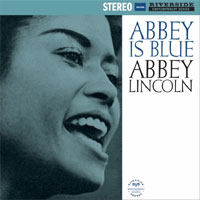Abbey Lincoln • Abbey Is Blue
The opener, “Afro Blue,” hints at what's to come. Lincoln is directly in front of the three playful horns (trumpet, trombone and tenor sax). Her exquisite, flinty voice is without artifact and sounds astonishingly present. The rhythm section, led by Max Roach, is set comfortably to the rear of the stage. After the song ends, there are a few seconds of silence then the next track. Wow! What happened here? On “Lonely House” she sounds icy, with sibilants capable of cutting hard cheese. Thinking something was wrong with my system, I swapped cartridges, but nothing changed. I turned to my computer and fired up the album on Quobuz at 24 bits/192kHz. It sounded the same. Lincoln’s own composition, “Let Up,” saw a return to the sonic excellence of the first track. Her natural-sounding, sultry vocal is up front on this languorous blues, and the band is way back in the mix. “Thursday’s Child” returns to the assault on the ears heard earlier, with out-of-control sibilants and overly hard vocals. Surprisingly, Ms. Lincoln is placed significantly back on the stage. Side one’s closer, “Brother, Where Are You?,” continues the aggressive sound heard on previous tracks. “Laugh Clown, Laugh” opens side two and it’s a winner, with Lincoln front and center, the band some distance behind. The slight reverb does not detract from the presentation. Instead, it allows the lyrics to be freed from the music in a quite dramatic and emotional way. Les Spann’s delicate guitar introduces a languid version of Duke Ellington’s most reverential composition, “Come Sunday,” with Ms. Lincoln placed deep in the soundstage. The ice has returned, unfortunately, and its glare proved distracting. The sibilants were out of control as well on the next track, “Softly, As In A Morning Sunrise,” with the treble seemingly pushed up to near ear-threatening levels. I guess in order to enjoy this album one has to get used to the wayward sibilants and awkward equalization, because they don't go completely away. This is a shame, because the next song, Kurt Weil’s “Lost In the Stars,” deserves the best sound possible. To my ears, it sounds like the recording of this tune took place in a cardboard tube. Finally, the album’s closer, “Long As You’re Living,” returns the sonics to their previous best. With Kevin Gray mastering, I’m convinced that what I heard was precisely what was captured on the master tapes, even though the sonics reflected early stereo (interestingly, although the jacket says “STEREO,” I got the impression on several of the tracks that I was listening to a mono recording) and the (then popular) hard panning of the left and right channels. I can’t explain the increased brightness and deadly sibilants on “Lonely House” and “Softly, As In A Morning Sunrise.” Is it due to a change in microphones, equalization or performer placement? I don’t know, so I’ll let those with greater insights into the production of this LP chime in. I’ve come to expect flat heavyweight vinyl, quiet surfaces and exceptional sound from Craft Recordings, and this LP, even with the listening quirks noted, was no exception. The tip-on jacket, artwork, liner notes and record labels are faithful to the original. Uneven sonics aside, what I do know is that
co-producer Orrin Keepnews summed it up best when he wrote about Abbey Is Blue,
“It stands up as among the most effective and moving albums that any singer has
created in a long time.” |

 ultitalented Abbey Lincoln enjoyed a career as jazz
vocalist, songwriter, award-winning actress and activist. Her final recording, for Verve
Records, was made just a few years before her death in 2010. Abbey Is Blue was
her fourth and last recording for Riverside before signing to Archie Bleyer’s Candid
label. From 1959, it presents the singer performing a group of personally chosen songs
backed by a small ensemble of then A-list musicians, including Stanley Turrentine, Kenny
Dorham, Julian Priester, Wynton Kelly, Cedar Walton, Sam Jones, Philly Joe Jones and Max
Roach, who became her husband. Lincoln bares her soul on Abbey Is Blue, venting
her rage and angst. She also demonstrates just how fine a musician, composer and singer
she is. With songs from writers such as Langston Hughes and Oscar Brown, Jr., the going
can get a bit rough at times -- especially since her delivery is similar to Billie
Holiday’s in its capacity to draw the listener into the turbulence contained within
the music. This vise-like, not-always-pleasant grip on our emotions is not an everyday
experience, making this an exceptional, if not always comforting, listen.
ultitalented Abbey Lincoln enjoyed a career as jazz
vocalist, songwriter, award-winning actress and activist. Her final recording, for Verve
Records, was made just a few years before her death in 2010. Abbey Is Blue was
her fourth and last recording for Riverside before signing to Archie Bleyer’s Candid
label. From 1959, it presents the singer performing a group of personally chosen songs
backed by a small ensemble of then A-list musicians, including Stanley Turrentine, Kenny
Dorham, Julian Priester, Wynton Kelly, Cedar Walton, Sam Jones, Philly Joe Jones and Max
Roach, who became her husband. Lincoln bares her soul on Abbey Is Blue, venting
her rage and angst. She also demonstrates just how fine a musician, composer and singer
she is. With songs from writers such as Langston Hughes and Oscar Brown, Jr., the going
can get a bit rough at times -- especially since her delivery is similar to Billie
Holiday’s in its capacity to draw the listener into the turbulence contained within
the music. This vise-like, not-always-pleasant grip on our emotions is not an everyday
experience, making this an exceptional, if not always comforting, listen.